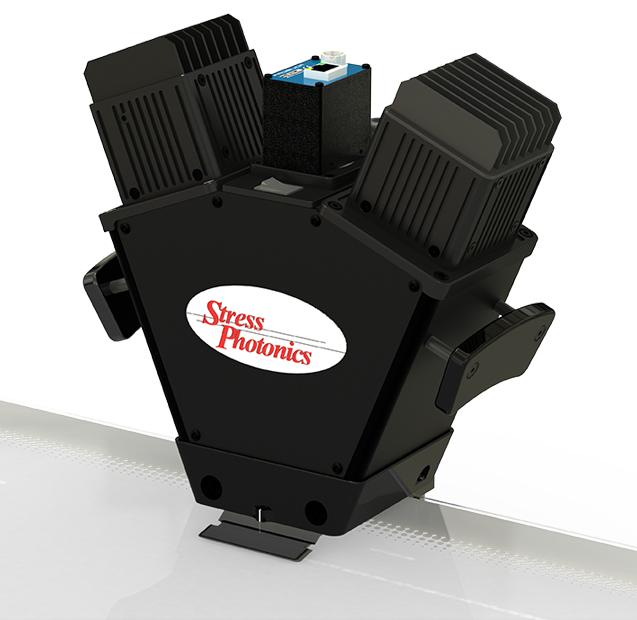+1 (608) 224-1230
Glass Inspection Products
We have an entire website dedicated to Glass Inspection Products! Visit GlassPhotonics.com for complete details about our full line of Glass Inspection Products!

With traditional photoelasticity, an engineer had to deal with the tedium of both coating applications and fringe counting. With the Grey Field Polariscope, Photoelastic Stress Analysis (PSA) is now fully automatic. After you paint, just aim the polariscope at your component or specimen and “shoot.” The image of the high strain or stress area is displayed digitally on the system’s computer. The GFP system interpolates the data and outputs an image showing the maximum inplane shear and the direction of the first principal strain.
Key Points about Photoelasticity
- Full-field
- Thin plastic coating
- In-plane shear strains
- Directions of principal strains
- Simple static loads including assembly stresses
- Should view normal to surface
- Can measure residual stress in glass and plastic
Key Features of GFP Systems
- Automated full-field strain measurement
- Compatible with all coatings
- Thickness measurement via tinted coatings
- 20 microstrain resolution typical
- Sub-fringe or multi-fringe
- Simple static loading
- Traceable system calibration
- No fringes to analyze
- Automatic measurement of coating thickness
- Fully computerized digital system
- Thin easier to apply coatings
Visit GlassPhotonics.com to learn more!
Technical specifications for our wide range of glass inspection tools vary depending on the system. We’ve developed an entire website dedicated to glass inspection tools and technology by Stress Photonics. Visit GlassPhotonics.com to learn more!
Glass Inspection
Photoelastic Stress Analysis for Glass Inspection
Grey-Field Polariscopes (GFP) illuminate the glass with achromatic circularly polarized light. If the glass is under stress, the circularly polarized light becomes elliptically polarized. The amount of ellipticity measured for Red, Green, and Blue light determines the stress level in the glass and the tilt of the ellipse indicates the direction of the stress. The stress measured is equivalent to
σx-σy
where sx is the normal stress in a given direction and sy is the orthganal normal stress. For measurements near the edge of glass sy = 0 when sx is chosen parallel to the edge. A direct measurement of edge stress is made.
All GFP systems can be used directly in black frit band.
Visit GlassPhotonics.com to learn more!
GFP Sensor
The GFP sensors incorporate rotating polarizers between the lens and camera to measure the dimensions of the ellipse. As the polarizer lines up with the long axis of a particular ellipse the pixel gets brighter, as the polarizer lines up with the short axis of the ellipse the pixel gets darker. The magnitude of flashing determines the stress and the phase of the flashing determines the direction of the stress. The flashing light is normalized by the average light to desensitize the measurement to quality of illumination.
Visit GlassPhotonics.com to learn more!
Simple User Interface
Detailed analysis and high quality presentation is performed using Stress Photonics’ DeltaVision™ software. The software allows GFP users to take advantage of powerful Windows software and network resources to process and present data quickly and easily.
Visit GlassPhotonics.com to learn more!
Flexible Design
The GFP systems are some of the most flexible stress measurement instruments Stress Photonics offers. They are fully automated video based systems capable of capturing full-field stress maps in less than 10s. They use standard interchangeable camera lenses, a light guide based illuminator and are managed via the DeltaVision control and analysis software. The GFP systems can be easily configured to make any of the basic glass measurements including edge stress, area stress and laminar stress. The GFP systems are true general purpose tools!
Visit GlassPhotonics.com to learn more!
Capable Instrumentation
- Superior graphics performance
- A variety of graphical data presentations
- Advanced data manipulation routines
- Quick and easy pull down menus
- Easy cut and paste of TIFF, PICT, JPEG, etc.
Visit GlassPhotonics.com to learn more!
Simple Operation
The GFP has many features that make operation simple.
- Video camera-like aiming and focusing
- Virtual instrument panel for control and image acquisition
- Video monitor feedback for quick and easy adjustments and optimization
Visit GlassPhotonics.com to learn more!
Visit GlassPhotonics.com Today!
Click the button below to go to the GlassPhotonics.com website where you will find detailed information and technical specifications for our full line of glass inspection instruments.
Go to GlassPhotonics.com
Stress Photonics products and expertise in Photoelastic and Thermoelastic methods are applicable to full-field stress and strain measurement, and glass inspection.
About
- History
- Leadership
- Markets
- Awards
Products
- DeltaTherm
- Grey Field Polariscope
- Glass Inspection
Applications
- Component Testing
- Glass Inspection
- Residual Stress in Transparent Materials
- Micro-mechanics
- FEA Validation
Getting Started
- Tutorials
- Resources